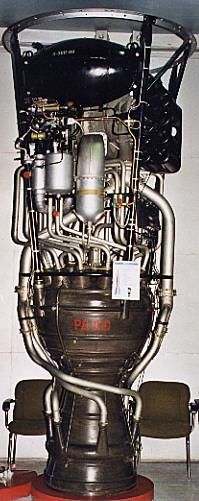
Home - Search - Browse - Alphabetic Index: 0- 1- 2- 3- 4- 5- 6- 7- 8- 9
A- B- C- D- E- F- G- H- I- J- K- L- M- N- O- P- Q- R- S- T- U- V- W- X- Y- Z
RD-100
 RD-100 NPO Enerogmash Museum Credit: © Dietrich Haeseler |
Date: 1946-50. Number: 184 . Thrust: 304.00 kN (68,341 lbf). Unfuelled mass: 885 kg (1,951 lb). Specific impulse: 237 s. Specific impulse sea level: 203 s. Burn time: 65 s. Height: 3.70 m (12.10 ft). Diameter: 1.65 m (5.41 ft).
German salaries and conditions were good - the chief of the German team receiving the second highest salary after the Soviet designer-in-chief. The RD-100 was built in 1946 at a former Ilyushin aviation plant that had been moved to Tashkent in World War 2 (now the Energomash factory). There was no equipment so everything had to be started from scratch. By mid-1947 the first RD-100 was ready. In May 1948 the first RD-100 test took place at Khimki itself, with the spectators watching from 1 km away. There are still tests at the same location but thrust levels are now 800 metric tons force. The R-1 rocket with the RD-100 engine entered service in 1950.
Thrust (sl): 267.000 kN (60,023 lbf). Thrust (sl): 27,227 kgf. Engine: 885 kg (1,951 lb). Chamber Pressure: 15.90 bar. Propellant Formulation: Lox/Alcohol-75%. Thrust to Weight Ratio: 35.3672316384181. Oxidizer to Fuel Ratio: 1.28.
Country: Russia. Launch Vehicles: R-1. Propellants: Lox/Alcohol. Stages: R-1 stage. Agency: Glushko bureau. Bibliography: 225, 287, 317, 321, 323, 342, 394.
Back to top of page
Home - Search - Browse - Alphabetic Index: 0- 1- 2- 3- 4- 5- 6- 7- 8- 9
A- B- C- D- E- F- G- H- I- J- K- L- M- N- O- P- Q- R- S- T- U- V- W- X- Y- Z
© 1997-2019 Mark Wade - Contact
© / Conditions for Use